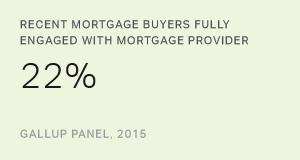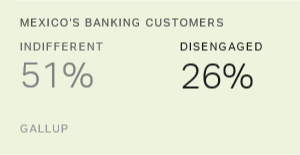Story Highlights
- Engaging mortgage customers can create more business with them
- Service, approval and closing processes are keys to engagement
- Mortgage providers need holistic view of services at each stage
Banks are at risk of squandering major business opportunities.
With the real estate market recovering from post-financial collapse levels, the demand for housing -- and mortgages -- is up. U.S. housing starts and purchases of existing homes rose in the second quarter of 2015, according to the U.S. Housing and Urban Development Department. A survey of senior loan officers also showed a moderately stronger demand for mortgages over the same period, according to the Federal Reserve Board. This improvement is in sharp contrast to the status of the housing market eight years ago when the housing bubble burst, sending the U.S. economy into recession.
As the housing market improves and more people consider a home purchase, there will be more opportunities for financial service firms to attract new customers -- or to cross-sell to current customers -- through the mortgage process.
Unfortunately for banks, that process is so full of uncertainty, miscommunication and poor service that it's one of the least engaging of all the financial services that banks provide. Only about one in five recent mortgage buyers (22%) are fully engaged with their mortgage provider.

Banks that can get this process right, however, can gain a serious advantage over their competitors. By engaging customers during the mortgage process, financial institutions can open the door to even more business with them. Nearly half of fully engaged mortgage-only customers (46%) also become retail customers of the bank holding their mortgage, compared with only 11% of actively disengaged mortgage-only customers.
Fully engaged customers are also emotionally and psychologically attached to the financial institution, and they are more than twice as likely to return to the same institution when they need another mortgage. Nine out of 10 are extremely likely to recommend the mortgage provider to others (93%), compared with only 3% of actively disengaged customers.
A recent Gallup study shows that only two in 10 mortgage customers are fully engaged with their mortgage provider (22%), while nearly half are indifferent (46%), and one-third are actively disengaged (32%). Given the opportunities for cross-selling and growth that fully engaged customers offer, banks need to do more to make the mortgage experience an engaging one. Gallup analysis found that banks can increase engagement by focusing on customer service and the approval and closing processes.
Providing Satisfying Service
Mortgages are complex transactions, and customers place many competing demands on their loan agents. As a result, mortgage service is difficult to do well.
Gallup examined several factors that are important to customers during the mortgage process and found there is no silver bullet that guarantees a great customer experience. However, if a loan agent gets these five elements right, they explain up to 43% of a customer's engagement with a mortgage provider:
- make it easy to do business with the mortgage provider
- be knowledgeable and competent
- help customers understand the mortgage process
- treat them like valued customers
- be responsive to customers' questions and concerns
Though all mortgage customers want their bank to make the loan process easy for them, various types of customers have different service priorities:
- First-time buyers want the bank to treat them like valued customers; when they apply for their first loan, they want the agent to help them understand how long the mortgage process will take. They become actively disengaged when the loan agent doesn't demonstrate an understanding of their financial situation or fails to set expectations when they apply about how long the process will take.
- Buyers who have purchased a mortgage before, on the other hand, want their loan agent to demonstrate knowledge and competence and to be responsive to their questions and concerns. They become actively disengaged when an agent fails to help them understand the mortgage process or isn't knowledgeable or competent.
- Customers who are refinancing become more engaged when the loan agent clearly explains the information and documents they need to provide and keeps them informed of the status of their mortgage. They become actively disengaged when their loan agent doesn't help them understand the mortgage process or isn't responsive to their questions or concerns.
Improving the Approval Process
During the approval process, customers want a quick approval and transparent communication about documentation requests. The majority of their satisfaction with the approval process depends on how long it takes to get approval (59%), and the longer it takes, the more frustrated customers become. Satisfaction levels drop precipitously the longer the process takes. Satisfaction with the approval time and process drops by more than one-third after customers wait more than two weeks for approval, yet 70% of buyers report waiting longer than that. Satisfaction continues to drop with every two weeks that go by.
Another problem that frustrates customers is having an agent ask them to provide additional documentation on top of the paperwork they have already completed. Most customers in the study (59%) report they were asked for additional documentation at least once during the approval process. In fact, more than a quarter (28%) were asked to provide documentation they had already supplied. In these situations, customer satisfaction understandably declines.
However, Gallup found that loan agents who provide a satisfactory explanation of why they require the documentation can mitigate the damage. Just 24% of customers report receiving a satisfactory explanation of why agents requested additional documentation, but for these lucky few, satisfaction with the approval process did not decline, even after multiple requests.
Simplifying the Closing Process
Customers who are extremely satisfied with the time it took to close the loan following the approval of their loan are substantially more satisfied with the closing process overall than those dissatisfied with the time it took to close the loan. Still, about 75% of a buyer's satisfaction with the closing process should focus on four elements, including:
- keeping the customer informed of the status of the closing documents
- providing clear closing documents and instructions
- ensuring the loan amount and terms are what the customer expected
- providing enough time for the customer to carefully read the closing documents
Keys to a Better Mortgage Experience
The mortgage process comprises dozens of touchpoints that influence customers' perceptions and affect their engagement with the mortgage provider. Their satisfaction with the process at every touchpoint influences whether they choose to do more business with the mortgage provider and urge their family and friends to do so.
Though speeding up approval and closing are important to improving engagement, re-engineering these processes likely will require operational changes and additional staff and training for many mortgage providers. But there are a few simple things banks can do right away to make the most of their budding relationships with their mortgage customers:
- Audit procedures, particularly in the approval and closing processes, to pinpoint simple shifts in responsibilities that might help to streamline the processes.
- Develop profiles for agent service based on different types of buyers, focusing on the needs and priorities specific to each type.
- Provide thorough explanations and answer questions when requesting additional documentation from customers to mitigate any potential negative effects.
- Set up automated reminders for loan agents to contact customers regularly and provide status updates, particularly when the process takes longer than expected.
- Develop and track customer engagement metrics, and conduct qualitative and quantitative research as needed to identify weak and strong performance areas.
Focusing on and instituting best practices at every twist and turn of the mortgage process can help providers clear barriers, putting banks on the right path to engaging more of their valuable customers.
This is the second article in a two-part series on improving the mortgage experience.
Survey Methods
Results are based on a Gallup Panel Web study completed by 1,627 national adults, aged 18 and older, conducted in July 2015. The Gallup Panel is a probability-based longitudinal panel of U.S. adults whom Gallup selects using random-digit-dial (RDD) phone interviews that cover landlines and cellphones. Gallup also uses address-based sampling methods to recruit panel members. The Gallup Panel is not an opt-in Panel, and Panel members do not receive incentives for participating. For results based on this sample, one can say that the maximum margin of sampling error is ±2.4 percentage points at the 95% confidence level. Margins of error are higher for subsamples. In addition to sampling error, question wording and practical difficulties in conducting surveys can introduce error or bias into the findings of public opinion polls.

